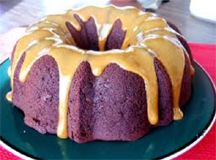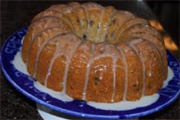Lucky Food for the New Year
By Alice Osborne
 All around the world people start their new year with a meal comprised of foods they consider to be “lucky” and “prosperity and happiness” inviting. My family is no exception. We understand the importance of having a blackeye pea dish on the New Year’s day menu. Blackeye peas (or any legume, really) are a symbol of money—they swell when cooked and money grows when wisely watched over. It’s a tradition I can believe in.
All around the world people start their new year with a meal comprised of foods they consider to be “lucky” and “prosperity and happiness” inviting. My family is no exception. We understand the importance of having a blackeye pea dish on the New Year’s day menu. Blackeye peas (or any legume, really) are a symbol of money—they swell when cooked and money grows when wisely watched over. It’s a tradition I can believe in.
 And my Aunt Annie always brought a collard greens dish to our family buffet (the greens at the table displayed our confidence for a prosperous new year). Any green will do, but collards is a southern tradition because they last so long in the garden, are affordable in the super markets, and their flavor blends nicely with pork (ham and bacon).
And my Aunt Annie always brought a collard greens dish to our family buffet (the greens at the table displayed our confidence for a prosperous new year). Any green will do, but collards is a southern tradition because they last so long in the garden, are affordable in the super markets, and their flavor blends nicely with pork (ham and bacon).
 Cakes and other baked goods are commonly served from Christmas to New Year's around the world, with a special emphasis placed on round or ring-shaped items. Italy has chiacchiere, which are honey-drenched balls of pasta dough fried and dusted with powdered sugar. Poland, Hungary, and the Netherlands also eat donuts, and Holland has ollie bollen, puffy, donut-like pastries filled with apples, raisins, and currants.
Cakes and other baked goods are commonly served from Christmas to New Year's around the world, with a special emphasis placed on round or ring-shaped items. Italy has chiacchiere, which are honey-drenched balls of pasta dough fried and dusted with powdered sugar. Poland, Hungary, and the Netherlands also eat donuts, and Holland has ollie bollen, puffy, donut-like pastries filled with apples, raisins, and currants.
 In certain cultures, it's customary to hide a special trinket or coin inside the cake—the recipient will be lucky in the new year. Mexico's rosca de reyes is a ring-shaped cake decorated with candied fruit and baked with one or more surprises inside. In Greece, a special round cake called vasilopita is baked with a coin hidden inside. At midnight or after the New Year's Day meal, the cake is cut, with the first piece going to St. Basil and the rest being distributed to guests in order of age. It seems the important and consistent tradition with the cake idea is including something in the batter—a coin, a nut, fruits, etc. The prune cake is a common New Year’s Day dessert because the prunes are considered so healthy and are readily available.
In certain cultures, it's customary to hide a special trinket or coin inside the cake—the recipient will be lucky in the new year. Mexico's rosca de reyes is a ring-shaped cake decorated with candied fruit and baked with one or more surprises inside. In Greece, a special round cake called vasilopita is baked with a coin hidden inside. At midnight or after the New Year's Day meal, the cake is cut, with the first piece going to St. Basil and the rest being distributed to guests in order of age. It seems the important and consistent tradition with the cake idea is including something in the batter—a coin, a nut, fruits, etc. The prune cake is a common New Year’s Day dessert because the prunes are considered so healthy and are readily available.
 Then there’s the pomegranate, considered a symbol of fertility, prosperity, and long life. In Greece, it is tradition to hang a pomegranate in front of each household's door on Christmas Day. At midnight on New Year's Eve, a person with good luck is chosen from the house to smash the fruit in front of or on the door. The number of seeds revealed indicates the amount of good luck members of the house will experience in the months to come. Tip: Wrap the pomegranate in foil before smashing to prevent a sticky mess.
Then there’s the pomegranate, considered a symbol of fertility, prosperity, and long life. In Greece, it is tradition to hang a pomegranate in front of each household's door on Christmas Day. At midnight on New Year's Eve, a person with good luck is chosen from the house to smash the fruit in front of or on the door. The number of seeds revealed indicates the amount of good luck members of the house will experience in the months to come. Tip: Wrap the pomegranate in foil before smashing to prevent a sticky mess.
 Just as it’s important to know what to eat on New Year’s Day, it’s also wise to know what not to eat. In addition to the aforementioned lucky foods, there are also a few to avoid. Lobster, for instance, is a bad idea because they move backwards and could therefore lead to setbacks. Chicken is also discouraged because the bird scratches backwards, which could cause regret or dwelling on the past. Another theory warns against eating any winged fowl because good luck could fly away.
Just as it’s important to know what to eat on New Year’s Day, it’s also wise to know what not to eat. In addition to the aforementioned lucky foods, there are also a few to avoid. Lobster, for instance, is a bad idea because they move backwards and could therefore lead to setbacks. Chicken is also discouraged because the bird scratches backwards, which could cause regret or dwelling on the past. Another theory warns against eating any winged fowl because good luck could fly away.
Now that we know what to eat, there's one more superstition—uh, guideline—to keep in mind. In Germany, it's customary to leave a little bit of each food on the plate past midnight to guarantee a stocked pantry in the New Year. Likewise in the Philippines, it's important to have food on the table at midnight. The conclusion? Let’s eat as much lucky food as we can, let’s just don't get too greedy—or the first place we'll be going in the new year is the gym!
If you’d like to entice some luck, health, prosperity, and happiness into your New Year, here are four recipes that incorporate four of the lucky foods mentioned above.
 Finally, I want to not just say “Happy New Year!”, but thank you for being part of our DVO Cook’n Club. Patty and I just love researching and writing for you! So here’s to a tasty, healthy, and delightful 2011 cooking experience!
Finally, I want to not just say “Happy New Year!”, but thank you for being part of our DVO Cook’n Club. Patty and I just love researching and writing for you! So here’s to a tasty, healthy, and delightful 2011 cooking experience!
Hoppin' John
Serves 6
 10 slices bacon
10 slices bacon
1/4 lb. smoked ham, coarsely chopped
¾ C chopped onion
1 garlic clove, minced
2 (15-oz.) cans blackeye peas, drained
3 C cooked brown rice
Pinch crushed red pepper
Salt to taste
1/8 tsp pepper
In medium saucepan, cook bacon until crisp. Drain on paper towels, reserving 3 tablespoons drippings in saucepan. Crumble bacon; set aside. Saute ham, onion and garlic in reserved drippings until onion is tender. Stir in peas, rice, hot pepper sauce, pepper and bacon; simmer until thoroughly heated. Salt to taste.
Favorite Collard Greens
Serves 4-6
 2 pounds of collard greens
2 pounds of collard greens
1 ham hock or 10 slices of cooked bacon
1 medium onion, sliced or chopped
1 tsp of crushed red pepper
2 to 3 tsp Kosher salt
Clean and wash greens well; remove tough stems and ribs. Cut them up and place in a deep pot; add onion. Wash off ham hock and add to the pot. Add red pepper and salt. Add enough water to cover greens and cook until tender, about 1 hour. Taste and adjust seasonings. Serve with sliced tomato and corn bread.
Pomegranate Ginger Muffins
Yield: 12 large or 24 medium muffinsPomegranate seeds and crystallized ginger are the flavor-boosters for these muffins. These muffins are great served warm or cool.
 2 cups all-purpose flour
2 cups all-purpose flour
2/3 cup sugar
1 Tbsp baking powder
1/2 tsp salt
1/3 C minced crystallized ginger
1 tsp grated lemon peel
1-1/4 C pomegranate seeds
1 C milk
1 large egg
About 1/4 C (1/8 pound) butter, melted and cooled
In a bowl, mix flour, sugar, baking powder, and salt. Stir in crystallized ginger, lemon peel, and pomegranate seeds. Make a well in the center. In a measuring cup, blend milk, egg, and butter. Pour liquid all at once into well. Stir just until batter is moistened; it will be lumpy.
Spoon batter into 12 (2-1/2-inch-wide) or 24 (1-3/4-inch-wide) buttered muffin cups, filling each almost to the rim. Sprinkle with 1 to 2 teaspoons sugar.
Bake in at 425 degrees until lightly browned, about 16 minutes for large muffins, 13 minutes for small. Remove muffins from pan at once. Yummy when served hot.
Aunt Annie's Prune Cake with Buttermilk Icing
 3 eggs, beaten
3 eggs, beaten1 c. vegetable oil
1 1/2 c. sugar
2 c. self-rising flour
1 tsp. allspice
1 tsp. cinnamon
1 tsp. nutmeg
1 c. milk
1 tsp. vanilla extract
1 c. cooked, finely chopped prunes (they chop easier if slightly frozen)
Buttermilk Icing
Combine eggs, oil and sugar in large mixing bowl. Mix well. Combine dry ingredients; add to oil mixture alternately with milk, beating well after each addition. Stir in vanilla and prunes.
Spoon batter into a greased 10-inch tube or bundt pan. Bake at 350 degrees for 45 to 50 minutes or until cake pulls away from sides of pan; cool. Spoon Buttermilk Icing over cake.
Buttermilk Icing
1 C firmly packed brown sugar
1/2 tsp. soda
1/4 C butter
1/2 C buttermilk
1/2 tsp. vanilla extract
Combine all ingredients except vanilla in saucepan. Cook about 5 minutes, stirring constantly. Remove from heat; add vanilla and beat well.
Read more about it at www.cooks.com/rec/view/0,196,152164-240205,00.html Content Copyright © 2010 Cooks.com - All rights reserved.

Contribute to the Cook'n Club!
DVO would love to publish your article, prose, photography and art as well as your cooking, kitchen and nutrition tips, tricks and secrets. Visit the Newsletter Submission / Win Win for All section in our Forum for more information and details.

